|
|
|
Sort Order |
|
|
|
Items / Page
|
|
|
|
|
|
|
| Srl | Item |
| 1 |
ID:
150831
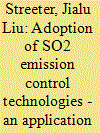

|
|
|
|
|
| Summary/Abstract |
Using data on coal-fired electric power plants, this article investigates the contributing factors affecting the investment decisions on flue-gas desulfurization (FGD), a capital-intensive emission control technology. The paper makes two contributions to the literature. First, the public regulatory status of electric power plants is found to have a strong influence on whether FGD investment is made. Compared to deregulated power plants, those that are still under rate-of-return regulations by Public Utility Commissions are more likely to install FGD. Second, a higher rate of inspections of polluting facilities (not just electric utility power plants) in a state in the previous year is associated with a higher probability of power plants adopting FGD this year. In addition, sulfur content of coal and plant size are both positively associated with the likelihood of FGD installation. The service length of boilers is negatively associated with the likelihood.
|
|
|
|
|
|
|
|
|
|
|
|
|
|
|
|
| 2 |
ID:
120813
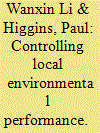

|
|
|
|
|
| Publication |
2013.
|
| Summary/Abstract |
Whether government has the political will and capacity to control pollution is crucial for environmental outcomes. A vast country such as China, with centralized policymaking but idiosyncratic local implementation of environmental regulations and drastic regional disparities in wealth, raises the question of how does the central government stimulate local environmental commitment to accommodate such diversity? In exploring this issue, this paper compares three national environmental management programs that are used as influencing and bargaining tools between the central and local governments of China: Quantitative Examination of Comprehensive Control of Urban Environment (1989), Model City for Protecting the Environment (1997) and pilot Green Gross Domestic Product (2005). Although the introduction of these schemes represents an important step forward in addressing demanding environmental issues their impact is found to be mixed. However, each scheme also has something important to offer to this particular realm of environmental management and by recognizing and compiling their comparative advantages a number of policy implications for future local commitment towards and capacity for environmental protection can be provided.
|
|
|
|
|
|
|
|
|
|
|
|
|
|
|
|
| 3 |
ID:
174979
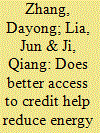

|
|
|
|
|
| Summary/Abstract |
Using firm-level data from the World Bank Enterprise Survey, this study investigates whether access to credit of a sample of Chinese manufacturing firms can affect the intensity of their energy use. Our empirical results show that firms with access to credit are associated with lower energy efficiency. In other words, firms with credit access tend to have significantly higher energy use per unit of output. This finding is robust to different measures of energy intensity and to varying specification of models. However, we find that local government environmental regulations can mitigate the financing-energy relationship: cities with stronger environmental regulations are able to reverse the relationship, in other words, firms’ access to financing is significantly associated with a reduction in their energy intensity. Our findings have important policy implications for Chinese authorities seeking more environmentally friendly development, and our conclusions suggest that energy efficiency should be considered as an additional condition for credit allocation to firms.
|
|
|
|
|
|
|
|
|
|
|
|
|
|
|
|
| 4 |
ID:
169759


|
|
|
|
|
| Summary/Abstract |
In this paper, we test the weak and strong versions of the Porter hypothesis using data from 14 OECD countries over the period 1990–2011. Our analysis makes two contributions to the literature on the topic. First, we use a newly released environmental policy stringency index (EPS) provided by the OECD as an indicator for the stringency of environmental regulations, which addresses the multi-dimensionality of environmental regulations. Second, as a suitable method to deal with asymmetric distributions of the dependent variables, we use a panel-quantile regression model, which allow us to test whether or not the hypothesis holds for all quantiles of the distribution of the corresponding dependent variable. The findings indicate that in the short term a more strict environmental policy is associated with an increase in the number of patent applications and in total factor productivity (TFP) for the highest quantiles of the distribution of patents and for all quantiles of TFP, respectively. Moreover, environmental stringency has a positive effect on research and development expenditures (RD) only in the lower quantiles (10, 25). In the long term, the EPS is affecting RD, patents and TFP in all quantiles, and hence more stringent environmental regulations promote cleaner production processes that could help improving energy efficiency.
|
|
|
|
|
|
|
|
|
|
|
|
|
|
|
|
| 5 |
ID:
086879
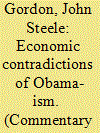

|
|
|
|
|
| Publication |
2009.
|
| Summary/Abstract |
On February 9th, President Obama visited Elkhart, Indiana, the American community with the country's highest unemployment rate, 15.3 percent. (It had been only 4.7 percent the year before.) He was there to sell his stimulus bill, then moving through Congress and since signed. He noted that the bill would provide help for the workers who had lost their jobs and, more important, help them get their jobs back by reviving the economy.
The jobs that have vanished in Elkhart are predominantly in the recreational-vehicle industry, which is concentrated in the city of 52,000. With the severe recession the country is now experiencing, it is hardly surprising that this industry has been devastated. After all, an RV is expensive both to purchase and to operate and is hardly a necessity. But when the economy recovers, will those jobs come back as demand for RV's returns? Or, in the meantime, will new environmental regulations championed by Obama work to impede the sales of vehicles that get only a few miles to the gallon and thereby make job growth in Elkhart an impossibility?
|
|
|
|
|
|
|
|
|
|
|
|
|
|
|
|
| 6 |
ID:
136207


|
|
|
|
|
| Summary/Abstract |
Shale gas development in China can generate great potential economic benefits, but also poses serious environmental risks. In this paper, we offer a macro assessment of the environmental risks of shale gas development in China. We use the US experience to identify the nature of shale gas development activities and the types of potential burdens these activities may create. We then review the baseline environmental conditions and the effectiveness of environmental regulations in China and discuss the implications of these China-specific factors for risk assessment. We recommend China to conduct a strategic environmental assessment and to consider sector-specific environmental regulations.
|
|
|
|
|
|
|
|
|
|
|
|
|
|
|
|
| 7 |
ID:
175010
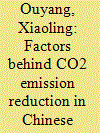

|
|
|
|
|
| Summary/Abstract |
As the most energy intensive industries, heavy industries are decisive for the realization of energy saving and emission reduction commitments. This study investigates factors behind CO2 emissions mitigation in China's heavy industries based on the system generalized method of moments (SYS-GMM) model. Results indicate that industrial structure (IS), fixed asset investment (F) and historical emissions are drivers for sectoral CO2 emission increase, while energy efficiency (EE) is a key factor for carbon emissions reduction. In order to further explore the effect of environmental regulations, we treat 2011 mandatory emission trading scheme (ETS) in high energy-consuming industries as a quasi-natural experiment, and conduct a Propensity Score Matching and Difference-in-Difference (PSM-DID) approach to analyze the policy effect. We find that the implementation of the mandatory emission reduction policy can reduce CO2 emissions of heavy industries, and the results are robust by testing the randomness of the policies. The policy implications are put forward to optimizing industrial structure and enhancing the environmental regulations in China's heavy industries.
|
|
|
|
|
|
|
|
|
|
|
|
|
|
|
|
| 8 |
ID:
146889


|
|
|
|
|
| Summary/Abstract |
In the last five years China has passed new regulations and formulated new policies to target urban smog. Accordingly, several cities have sought to improve their public transportation systems to reduce the number of motor vehicles on the streets. In 2011 in Nanjing, during the construction of Line No. 3 of the subway system, several long-standing London plane trees in the city’s historical area were targeted for transplantation. This article focuses on the tree-hugging protest which was triggered by this event in 2011–12. While protesters framed their actions as tree protection and heritage conservation, this article is particularly interested in participatory approaches available to protesters, in light of certain recent developments in the environmental regulatory framework in China. Specifically, this article analyses a relatively new and less well-known tool for popular participation known as ‘green assessment’.
|
|
|
|
|
|
|
|
|
|
|
|
|
|
|
|
| 9 |
ID:
176114


|
|
|
|
|
| Summary/Abstract |
Sulfur dioxide (SO2) emissions from coal-fired power plants in China have declined significantly since an incentive-based policy named as the desulfurated electricity pricing premium program (DEPPP) was implemented for all coal-fired power plants in 2006. Using industrial pollution panel data from 350 prefectures in China and difference-in-differences models, we estimate causal effects of the DEPPP on the coal-fired power plants. We find that the DEPPP provided the coal-fired power plants strong incentives to invest in capital-intensive flue gas desulfurization (FGD) equipment and to operate the installed FGD at a higher rate, and thus contributed to significant reductions in total SO2 emissions in China. Our results suggest that the DEPPP reduced uncertainty faced by the coal-fired power plants when making large capital investments in SO2 abatement techniques such as FGD to comply with stringent environmental regulations. However, the DEPPP may not be cost-effective in reducing SO2 emissions given heterogeneous marginal costs for operating FGD units in different coal-fired power plants. Furthermore, the effectiveness of the DEPPP also depends on strengthened environmental regulatory capacities to enforce coal-fired power plants to comply with the operating rate requirement for the installed FGD.
|
|
|
|
|
|
|
|
|
|
|
|
|
|
|
|
|
|
|
|
|